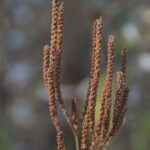swamp vervain
Verbena hastata

Description:
Also called blue vervain, this slender, erect, herbaceous perennial plant that is up to 60″ tall. It is found in wetlands and stream corridors across Wisconsin. Swamp vervain is an early colonizer following disturbance. Its small blue flowers appear along a florescence stalk in July and continue blooming into early September. The flowers are replaced by small nutlets (4 nutlets per flower).
Details:
swamp vervain
| USDA Symbol: | Common Name: | Scientific Name: |
|---|---|---|
| VEHA2 | swamp verbena | Verbena hastata |
ITIS TSN: 32071
Category: Dicot
Taxonomy
Kingdom: Plantae
Subkingdom:
Super Division: Spermatophyta
Division: Magnoliophyta
Subdivision:
Class: Magnoliopsida
SubClass: Asteridae
Order: Lamiales
Family: Verbenaceae
Counties: Adams, Ashland, Barron, Bayfield, Brown, Buffalo, Burnett, Calumet, Chippewa, Clark, Columbia, Crawford, Dane, Dodge, Door, Douglas, Dunn, Eau Claire, Florence, Fond du Lac, Forest, Grant, Green, Green Lake, Iowa, Iron, Jackson, Jefferson, Juneau, Kenosha, Kewaunee, La Crosse, Lafayette, Langlade, Lincoln, Manitowoc, Marathon, Marinette, Marquette, Menominee, Milwaukee, Monroe, Oconto, Oneida, Outagamie, Ozaukee, Pierce, Polk, Portage, Price, Racine, Richland, Rock, Rusk, Sauk, Sawyer, Shawano, Sheboygan, St. Croix, Taylor, Trempealeau, Vernon, Vilas, Walworth, Washburn, Washington, Waukesha, Waupaca, Waushara, Winnebago, Wood
Active Growth Period: Spring, Summer and Fall
Carbon to Nitrogen Ratio:
Conspicuous Fall Color: No
Fire Resistant: No
Flower Color: Blue
Conspicuous Flower: Yes
Foliage Color: Green
Foliage Light Porosity Summer:
Foliage Texture: Medium
Fruit/Seed Color: Brown
Growth Form: Single Stem
Growth Rate: Moderate
Height at Base Age (Max):
Known Alelopath:
Leaf Retention: No
Re-sproutability:
Shape and Orientation: Erect
Toxicity: None
Height (min): 16
Height (max): 60
Root Type: Fibrous
Leaf Type: simple
Leaf Arrangement: opposite
Leaf Shape: lanceolate
Vein Pattern:
Adapted to Coarse Textured Soils:
Adapted to Medium Textured Soils:
Adapted to Fine Textured Soils:
Hedge Tolerance: None
Moisture Use: Medium, High, Low
pH (Minimum):
pH (Maximum):
Planting Density per Acre, Minimum:
Planting Density per Acre, Maximum:
Precipitation (Minimum):
Precipitation (Maximum):
Root Depth, Minimum (inches):
Plant Spacing (min): 18
Plant Spacing (max): 24
| Bloom Period: | Commercial Availability: | Fruit/Seed Abundance: |
|---|---|---|
| Fruit/Seed Period Begin: | Fruit/Seed Period End: | Fruit/Seed Persistence: |
|---|---|---|
| Propogated by Bare Root: | Propogated by Bulbs: | Propogated by Container: |
|---|---|---|
| No | Yes |
| Propogated by Corms: | Propogated by Cuttings: | Propogated by Seed: |
|---|---|---|
| No | No | Yes |
| Propogated by Sod: | Propogated by Sprigs: | Propogated by Tubers: |
|---|---|---|
| No | No | No |
| Seeds per Pound: | Seed Spread Rate: | Seedling Vigor: |
|---|---|---|
| 1488000 |
| Small Grain: | Vegetative Spread Rate: | Propagation Treatment: |
|---|---|---|
| No | Moist Stratification |
| Days to Stratify: | Direct Sowing Time: |
|---|---|
| 30 | Fall |
Benefits: Birds, Butterflies, Hummingbirds, Pollinators, Deer Resistant
| Berry/Nut/Seed Product: | Christmas Tree Product: | Fodder Product: |
|---|---|---|
| No | No | No |
| Fuelwood Product: | Lumber Product: | Naval Store Product: |
|---|---|---|
| No | No | No |
| Nursery Stock Product: | Palatable Browse Animal: | Palatable Graze Animal: |
|---|---|---|
| Yes | -- | -- |
| Palatable Human: | Post Product: | Protein Potential: |
|---|---|---|
| No | No | -- |
| Pulpwood Product: | Veneer Product: |
|---|---|
| No | No |
| Benefits: | Wildlife Food Value: | Wildlife Cover Value: |
|---|---|---|
| Birds, Butterflies, Hummingbirds, Pollinators, Deer Resistant |
References:
- Illinois Wildflower Database – Verbena hastata
- USDA Plants Database – Verbena hastata
- Wisflora Database – Verbena hastata
Return to Native Plants page
